English actress Eva Moore (1870–1955) had a career on stage and in film which spanned six decades. She was active in the women's suffrage movement, and from 1920 on, she appeared in over two dozen films.
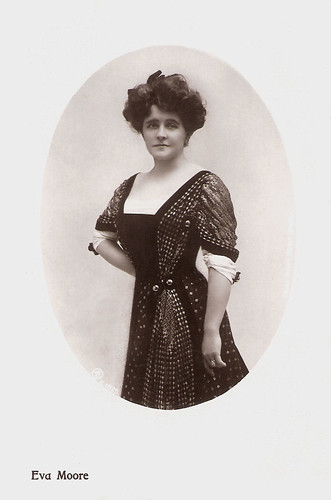
British postcard in the Satinetti Series by Aristophot. Co. Ltd, London.
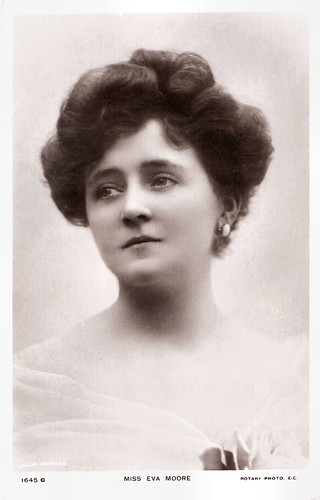
British postcard in the Rotary Photographic Series, no. 1645 G. Photo: Lallie Charles.

British postcard by Beagles' Postcards, no. 235 M. Photo: Dover St. Studios.

British postcard by Rotary Photo. Photo: Johnston & Hoffmann.
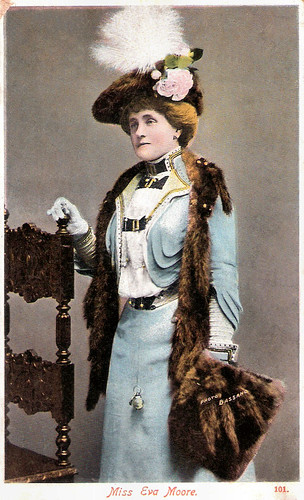
British postcard in the Ducal Series, no. 101. Photo: Bassano.
Eva Moore was born in Brighton, England, in 1870. She was the daughter of Edmund Henry Moore by his spouse Emily née Strachan. Her sister was the actress Decima Moore.
Eva made her first stage appearance at London's Vaudeville Theatre in 1887, as Varney in 'Proposals'. She next joined Toole's company.
In 1891, she married the actor Henry V. Esmond. They had two children, racecar driver Jack Esmond and actress Jill Esmond, the first wife of Laurence Olivier.
In 1892, Eva appeared in 'The Mountebanks' by W. S. Gilbert and Alfred Cellier. In 1894, she joined Charles Hawtrey and Lottie Venne in F. C. Burnand's 'A Gay Widow'. Other stage roles included Mabel Vaughn in 'The Wilderness' (1901); Lady Ernestine in Esmond's 'My Lady Cirtue' and Wilhelmina Marr in his 'Billy's Little Love Affair' (both in 1903); and Kathie in 'Old Heidelberg' (1902 and 1909) with George Alexander.
In 1907, she took the name part in 'Sweet Kitty Bellaire' (1907); and she played Mrs. Errol in 'Little Lord Fauntleroy' and Mrs. Crowley in 'The Explorer' in 1908, and the Hon. Mrs. Bayle in 'Best People' and the Hon. Mrs. Rivers in 'The House Opposite' in 1909. She later managed the Henry V. Esmond comedy 'Eliza Comes to Stay', which opened at the Criterion Theatre in 1913, transferring to the Vaudeville in 1914.
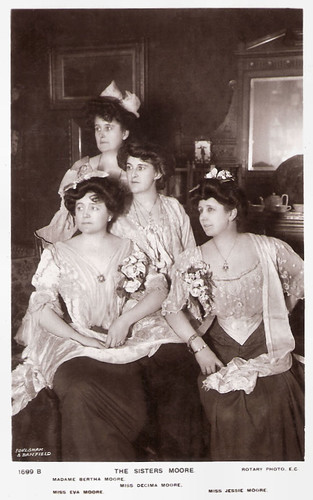
Decima, Bertha, Eva and Jessie Moore. British postcard in the Rotary Photographic Series, no. 1699 B. Photo: Foulsham & Banfield.

Decima, Bertha, Eva and Jessie Moore. British postcard in the Rotary Photographic Series, no. 1699. Photo: Adolphus Tear.

British postcard in the Rotary Photographic Series, no. 1645 H. Photo: Foulsham & Banfield. Eva Moore's son later became race car driver Jack Esmond.
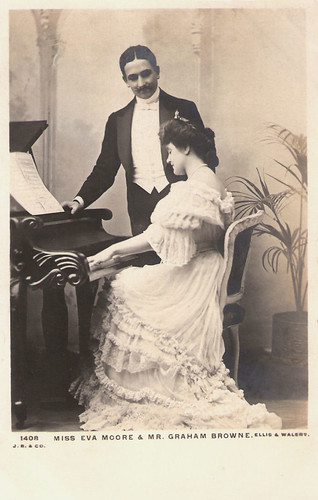
Eva Moore and Graham Browne. British postcard by J.Beagles & Co., London, no. 1408. Photo: Ellis & Walery.

British postcard in the Rotary Photographic Series, no. 3254 C. Photo: Dover St. Studio. Publicity still for the stage play Lights Out (1905-1906) with Eva Moore as Klara Volkhardt and Henry V. Esmond (Eva Moore's husband) as Corporal Helbig. Corporal Helbig: "You are not speaking the truth".

British postcard by Davidson Bros. in the Glossyphoto series, no. 1170. Sent by mail in 1905. Photo: Bassano.
After World War I broke out, Eva Moore continued acting at the Vaudeville in the evenings but worked as a volunteer for the Women's Emergency Corps, based at the Little Theatre, during the day. In October 1920, she and Esmond toured Canada with Nigel Bruce as their stage manager, who also played Montague Jordan in 'Eliza Comes to Stay', which re-opened at the Duke of York's Theatre in London on 14 June 1923. Moore was active in the suffrage movement, as was her sister Decima, attending meetings and appearing in suffragist plays and films.
From 1920 to 1946, she made over two dozen films, beginning with The Law Divine (H.B. Parkinson, Challis Sanderson, 1920), co-starring with her husband, Henry V. Esmond. Some of her best-received silent films were The Crimson Circle (George Ridgwell, 1922), Chu-Chin-Chow (Herbert Wilcox, 1923) starring Betty Blythe, The Great Well (Henry Kolker, 1924) and the war drama Motherland (G.B. Samuelson, 1927).
As a trained stage actress, she had had no problems with the transition to the sound film era. Her most popular British ‘talkies’ included Almost a Divorce (Jack Raymond, Arthur Varney, 1931), I Was a Spy (Victor Saville, 1933) starring Madeleine Carroll, Jew Süss (Lothar Mendes, 1934) with Conrad Veidt, and The Divorce of Lady X (Tim Whelan, 1938), which starred her son-in-law Laurence Olivier.
In Hollywood, she appeared with Charles Laughton and Boris Karloff in the classic Horror film The Old Dark House (James Whale, 1932). Later films were the Hollywood production, Of Human Bondage (Edmund Goulding, 1946) starring Paul Henreid, and her final film, A Son Is Born (Eric Porter, 1946) with Peter Finch.
She published her reminiscences under the title of 'Exits and Entrances'. Eva Moore died in 1955 in Maidenhead, England, aged 85. Her grandson is producer-director Tarquin Olivier.

British postcard in the Rotary Photographic series, no. 1645 B. Photo: Johnston & Hoffmann.

British postcard. Sent by mail in 1904. Photo: Johnston & Hoffmann.

British postcard by Rotary Photo, no. 1645 R. Photo: Foylman & Banfield. Publicity still for the stage play 'The Best People'.

British postcard in the Yes or No? series. Sent by mail in 1904.
Clip from The Old Dark House (James Whale, 1932) with Gloria Stuart. Source: Evan Johnson (YouTube).
Sources: Thomas Staedeli (Cyranos), Wikipedia and IMDb.
This post was last updated on 22 October 2025.

British postcard in the Satinetti Series by Aristophot. Co. Ltd, London.

British postcard in the Rotary Photographic Series, no. 1645 G. Photo: Lallie Charles.

British postcard by Beagles' Postcards, no. 235 M. Photo: Dover St. Studios.

British postcard by Rotary Photo. Photo: Johnston & Hoffmann.

British postcard in the Ducal Series, no. 101. Photo: Bassano.
Olivier´s mom-in-Law
Eva Moore was born in Brighton, England, in 1870. She was the daughter of Edmund Henry Moore by his spouse Emily née Strachan. Her sister was the actress Decima Moore.
Eva made her first stage appearance at London's Vaudeville Theatre in 1887, as Varney in 'Proposals'. She next joined Toole's company.
In 1891, she married the actor Henry V. Esmond. They had two children, racecar driver Jack Esmond and actress Jill Esmond, the first wife of Laurence Olivier.
In 1892, Eva appeared in 'The Mountebanks' by W. S. Gilbert and Alfred Cellier. In 1894, she joined Charles Hawtrey and Lottie Venne in F. C. Burnand's 'A Gay Widow'. Other stage roles included Mabel Vaughn in 'The Wilderness' (1901); Lady Ernestine in Esmond's 'My Lady Cirtue' and Wilhelmina Marr in his 'Billy's Little Love Affair' (both in 1903); and Kathie in 'Old Heidelberg' (1902 and 1909) with George Alexander.
In 1907, she took the name part in 'Sweet Kitty Bellaire' (1907); and she played Mrs. Errol in 'Little Lord Fauntleroy' and Mrs. Crowley in 'The Explorer' in 1908, and the Hon. Mrs. Bayle in 'Best People' and the Hon. Mrs. Rivers in 'The House Opposite' in 1909. She later managed the Henry V. Esmond comedy 'Eliza Comes to Stay', which opened at the Criterion Theatre in 1913, transferring to the Vaudeville in 1914.

Decima, Bertha, Eva and Jessie Moore. British postcard in the Rotary Photographic Series, no. 1699 B. Photo: Foulsham & Banfield.

Decima, Bertha, Eva and Jessie Moore. British postcard in the Rotary Photographic Series, no. 1699. Photo: Adolphus Tear.

British postcard in the Rotary Photographic Series, no. 1645 H. Photo: Foulsham & Banfield. Eva Moore's son later became race car driver Jack Esmond.

Eva Moore and Graham Browne. British postcard by J.Beagles & Co., London, no. 1408. Photo: Ellis & Walery.

British postcard in the Rotary Photographic Series, no. 3254 C. Photo: Dover St. Studio. Publicity still for the stage play Lights Out (1905-1906) with Eva Moore as Klara Volkhardt and Henry V. Esmond (Eva Moore's husband) as Corporal Helbig. Corporal Helbig: "You are not speaking the truth".

British postcard by Davidson Bros. in the Glossyphoto series, no. 1170. Sent by mail in 1905. Photo: Bassano.
Suffragette
After World War I broke out, Eva Moore continued acting at the Vaudeville in the evenings but worked as a volunteer for the Women's Emergency Corps, based at the Little Theatre, during the day. In October 1920, she and Esmond toured Canada with Nigel Bruce as their stage manager, who also played Montague Jordan in 'Eliza Comes to Stay', which re-opened at the Duke of York's Theatre in London on 14 June 1923. Moore was active in the suffrage movement, as was her sister Decima, attending meetings and appearing in suffragist plays and films.
From 1920 to 1946, she made over two dozen films, beginning with The Law Divine (H.B. Parkinson, Challis Sanderson, 1920), co-starring with her husband, Henry V. Esmond. Some of her best-received silent films were The Crimson Circle (George Ridgwell, 1922), Chu-Chin-Chow (Herbert Wilcox, 1923) starring Betty Blythe, The Great Well (Henry Kolker, 1924) and the war drama Motherland (G.B. Samuelson, 1927).
As a trained stage actress, she had had no problems with the transition to the sound film era. Her most popular British ‘talkies’ included Almost a Divorce (Jack Raymond, Arthur Varney, 1931), I Was a Spy (Victor Saville, 1933) starring Madeleine Carroll, Jew Süss (Lothar Mendes, 1934) with Conrad Veidt, and The Divorce of Lady X (Tim Whelan, 1938), which starred her son-in-law Laurence Olivier.
In Hollywood, she appeared with Charles Laughton and Boris Karloff in the classic Horror film The Old Dark House (James Whale, 1932). Later films were the Hollywood production, Of Human Bondage (Edmund Goulding, 1946) starring Paul Henreid, and her final film, A Son Is Born (Eric Porter, 1946) with Peter Finch.
She published her reminiscences under the title of 'Exits and Entrances'. Eva Moore died in 1955 in Maidenhead, England, aged 85. Her grandson is producer-director Tarquin Olivier.

British postcard in the Rotary Photographic series, no. 1645 B. Photo: Johnston & Hoffmann.

British postcard. Sent by mail in 1904. Photo: Johnston & Hoffmann.

British postcard by Rotary Photo, no. 1645 R. Photo: Foylman & Banfield. Publicity still for the stage play 'The Best People'.

British postcard in the Yes or No? series. Sent by mail in 1904.
Clip from The Old Dark House (James Whale, 1932) with Gloria Stuart. Source: Evan Johnson (YouTube).
Sources: Thomas Staedeli (Cyranos), Wikipedia and IMDb.
This post was last updated on 22 October 2025.
I'm always here. Do not forget your beautiful and dense blog.
ReplyDeleteGreetings, I hope your visit and comments
www.ofalcaomaltes.blogspot.com